Top Business Intelligence predictions for 2013 (Part One)
You didn’t think we’d forgotten, did you? Hardly. While industry insiders, commentators, pundits and interest groups vaunted their respective prophecies for Business Intelligence (BI) in 2013, we waited. Biding our time, anticipating the perfect moment to act – emulating our favorite fearless (and peerless) figures. Like Superman’s last-ditch lunge to salvage Lois Lane from the diabolical deeds of Lex Luthor; Robin Hood’s eleventh-hour heroics to hoodwink the rich and rescue Maid Marian; or James Bond’s nick-of-time negation of the nebulous Dr. No.

Our just-in-time predictions spawn from two overarching trends, which are set to encapsulate and define BI in 2013. This year, the major advancements of the BI industry will result from the maturation and convergence of the industry’s most prominent developments.
1. BI usage will explode
Over the past two years, BI has moved into the mainstream – people know what it is, they understand its potential benefits, and many have already acted. In 2013, ambition and investment will be realized via tangible BI deployments. A Computer Weekly poll on major enterprise IT investments for 2013 revealed that 78 percent of respondents had BI at the top of their priority list. And, once again, analytics and BI ranked as the number one tech priority in Gartner’s most recent annual CIO study.

Warning: Images may be prone to DRASTIC metaphorical exaggeration…
A joint TechRepublic – ZDNet analytics and Big Data study, conducted in November 2012 and comprising survey results from 1,300 of their worldwide readership, provided strong evidence of ballooning usage. A majority (51.7%) of respondents said they used data analytics to make business decision on a daily basis. A further 18.1 percent plan to deploy some form of business analytics implementation over the next 12 months meaning that, if these plans come to fruition, almost 70 percent of global businesses will have an analytics project in place by the conclusion of 2013.
Research from independent technology and market research firm, Pringle & Company, suggests a complimentary trend, estimating that the global market for BI software and associated services will roughly double over the next four years. The firm approximates that the global BI software and services market will rapidly expand from $79 billion in 2012, to $143 billion in 2016.
Pringle & Company’s Principal Analyst, Tom Pringle, said that the findings – based on The Business Intelligence Software & Services Market, 2011-2016 market study – were being driven by the proliferation of data, data types and the broad potential uses of BI.

“As data volume and variety grows ever bigger, the necessary investment in technology and services to understand and successfully exploit its value will have to rise. Such high levels reflect not only growing understanding of the real-world business value of data-driven insights, but also demonstrate the substantial range and depth of skills required to adopt the necessary systems to successfully discover and act on them.”
Forrester Research predicts that global enterprise IT spending will increase by 5.4 percent during 2013, with BI and analytics as a major stimulant. The firm estimates global BI investments to rise by 11 percent in 2013, and a further 16 percent from 2013 levels in 2014.
“CIOs can expect to see their competitors doing a lot more on mobility, collaboration and business intelligence,” said Forrester analyst Andrew Bartels, in an interview with CIO Journal. “If you’re not doing these three things, there is a severe risk you’re going to fall behind.”
2. BI adoption to (finally) surge in 2013
Low, and long vaunted, BI user adoption rates will also improve in 2013 – for two reasons. As continued investments in 2013 boost the prevalence of BI throughout organizations and most major industries, sustained user adoption will follow as many nah-sayers witness the benefits of day-to-day fact-based decision-making first hand. Secondly, contemporary BI vendors are harnessing, developing and delivering modern functionalities – capable of bridging the historical complexity of traditional BI tools – which truly cater for the demands of an increasingly non-technical audience. Just think intuitive drag-and-drag interfaces, ‘self-service’ data exploration, instinctive visualization, mobile delivery that supports device independence, and collaborative features that enable both accurate dissection of information, as well as faster, smarter action by supporting natural organizational decision-making processes.
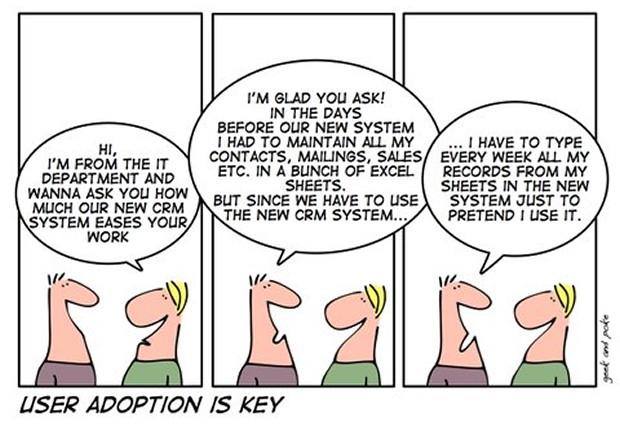
Nucleus Research predicts that infamously low BI user adoption rates will double during 2013, with Nucleus Research Principal Analyst, Hyoun Park, stating that the firm estimates regular analytics use to rise to around 30 percent within most enterprises inside the next 12 months. Park stated that this rise would be driven by the realization that “nearly all business decisions can be data-based.”
“Nucleus expects BI adoption will double worldwide in 2013 as greater usability for non-expert analytics users, lower-cost options including cloud and SaaS, and further efforts by vendors to make BI accessible to every user, will drive broader adoption of BI,” said Park.
3. 2013 will NOT be the year Excel ‘kills’ BI
When will BI be killed by Excel? This – one would have to assume deliberatively inflammatory question – was posted about this time last year on the Business Intelligence Group LinkedIn group. Almost 1000 comments later, this frequently fiery thread reached its apparent conclusion just last week after a string of narcissistic, antagonist and straight-out insulting exchanges. So why was this conversation so hotly contested? Well, many contributors probably felt the need to justify the legitimacy of their career, organization and industry. Evidently others were provoked by the irrationality of the question. There are many good arguments that expound BI’s worth. Aside from the breadth, depth and fluidity of modern BI functionality far outstripping Excel in many ways, Aditya Satyadev – a self-described entrepreneur from India – probably summed the debate up best: “the basic constraint with excel is that it’s a desktop application. You can load as much data as you want, and conduct your analysis, but when it comes to sharing the analysis / information across the enterprise, it becomes a bottleneck. Also, with everyone trying to do their own analysis on Excel, consistency of view is compromised – multiple versions will inevitably float across the enterprise.”
Ultimately, if Excel adequately addressed present-day reporting requirements, the modern BI industry wouldn’t be flourishing.

Ventana Research’s benchmark report – Decision-Making and Performance: Improving Essential Business Analytics and Technologies – highlights both the reliance on, and trepidation associated with, Excel for reporting. The report, based on a survey of business analysts, found that 78 percent of respondents regarded spreadsheets as an “important” or “very important” component of enterprise reporting. Simultaneously however, a mere 29 percent said they would trust the information within a spreadsheet.
Another Ventana report – Requirements for 21st Century Spreadsheets: Uses and misuses of a critical business technology – exposed the roots of this common mistrust, with 50 percent of survey participants admitting to “frequently” finding “major errors” in spreadsheets used for reporting. Further, 42 percent said that they discovered out-of-date information “frequently” or “all the time”.
So perhaps the more appropriate question would be to ask ‘when will Excel be killed by BI?’ But, with an estimated 500 million active Excel users worldwide, the premise of that question won’t eventuate either – at least not this year, or anytime in the foreseeable future.
If anything, it’s more likely that Excel will succumb to internal forces – Microsoft deciding to update and repackage the value that Excel offers into a new product – than external.
4. Mobile BI is now a ‘must have’
Forget it. 2013 isn’t the year of the snake. It’s the year of Mobile BI. Or, more particularly, it’s the year Mobile BI will transition from a point of differentiation – embraced by leading BI deployments – to a ‘must have’ checklist item for organizations serious about their BI implementations.

Must have Mobile BI mentality
Independent analyst and advisory firm, BI Scorecard, surveyed 634 BI practitioners in its 2012 Successful BI Survey, its sixth and most recent version of its report into BI adoption and trends.
As reported by Information Management, when asked what BI functionality and improvements they would be looking to adopt and embrace for 2013, 47 percent of respondents listed Mobile BI, only narrowly behind BI mainstay the dashboard (52%).
Results from BI Scorecard’s investigation were substantiated by findings from Forrester Research. Forrester’s most recent survey-based research indicates that around 25 percent of enterprises are already using Mobile BI applications, with a further 37 percent planning Mobile BI implementations in the short-term.
Principal analyst at Forrester Research, Boris Evelson, recently commented that: "Mobility is no longer a ‘nice to have’ – it will become the new BI mantra. Currently, Mobile BI adoption is behind the curve compared with other enterprise mobile applications. This is mainly due to the perceived lack of specific business use cases and tangible ROI. But Mobile BI caught up in 2012, will continue to progress in 2013, and will eventually become the norm. Why? Information workers can no longer wait to make decisions until they get back to the office – that may be too late."
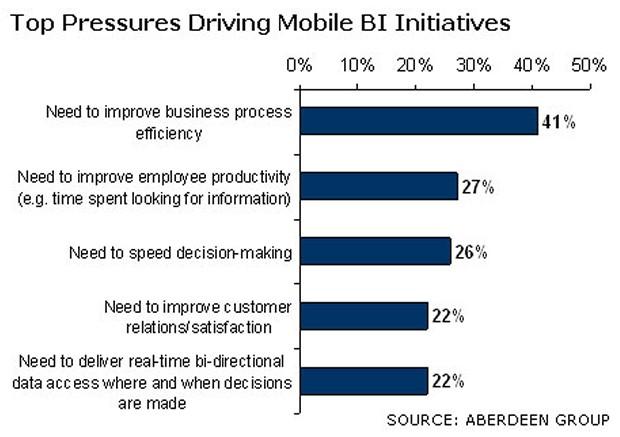
As participants could select multiple 'drivers'; the total percentage will not equal 100
Results from a recent study by market intelligence firm, TechNavio, back Boris’ viewpoint, forecasting the worldwide Mobile BI market to increase at a compound annual growth rate of 27.47 percent over the period 2012 – 2016. The report, entitled 2012-2016: Global Mobile Business Intelligence Market, put total spend on Mobile BI devices and software at $702 million in 2012, predicting that figure to rise by another 25 percent to $878.1 million in 2013, reaching a staggering $1.8 billion by 2016.
The report identified marked increase in Mobile BI usage for sales-related activities as a major catalyst driving general Mobile BI usage throughout 2013.
Mobile BI to boost lackluster BI adoption rates in 2013
Rates of BI adoption have been a consistent talking point within the BI industry. Numerous research firms estimate adoption rates to languish anywhere between eight and 24 percent of potential users.
However, it’s likely that increased Mobile BI adoption in 2013 will help address this persistent problem – according to BI Scorecard founder, and author of the 2012 Successful BI Survey, Cindi Howson.
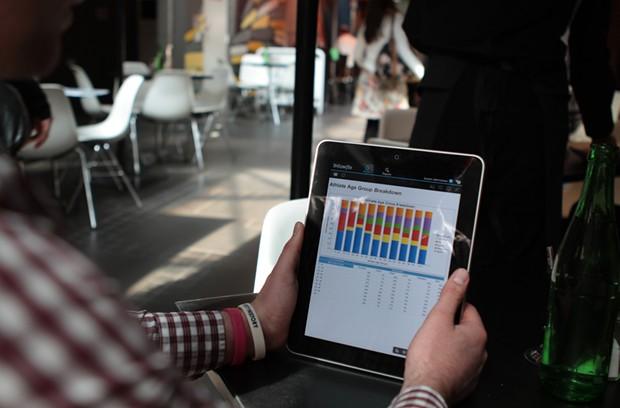
“Only a minority of companies have deployed Mobile BI, but for the ones who are successful, the adoption rate is at 39 percent,” commented Howson in relation to her 2012 Successful BI Survey. “That’s at least 15 percent higher than the industry average. I think it will be the technology that helps BI become more mainstream and impactful.”
Fellow research and advisory firm, Nucleus Research, came to a similar conclusion in its eleventh annual Top 10 Technology Predictions for 2013. Nucleus Research forecast that BI adoption would double worldwide in 2013, citing “further efforts from vendors to make analytics accessible to every user”.
Specialist Mobile BI analyst, Gartner’s Joao Tapadinhas, recently echoed that sentiment, predicating that Mobile BI users would constitute over 30 percent of the number of overall BI users, worldwide, by 2016.
Mobile BI usage spurred by proliferation of work-oriented tablets
The continued penetration of new mobile devices into the workplace will also assist the uptake of Mobile BI in 2013.
IDG Connect’s Global tablet ownership report suggests, based on a sample of 3124 respondents, that 71 percent of business and IT professionals own a tablet, with 61 percent of those tablet-owning-executives using this mobile device on a daily basis at work. Notably, of those executives who don’t currently own a tablet, 80 percent plan on purchasing one within the next 12 months. Consequently, IDG Connect predicts that by the end of 2013, over 94 percent of professionals will own a tablet.
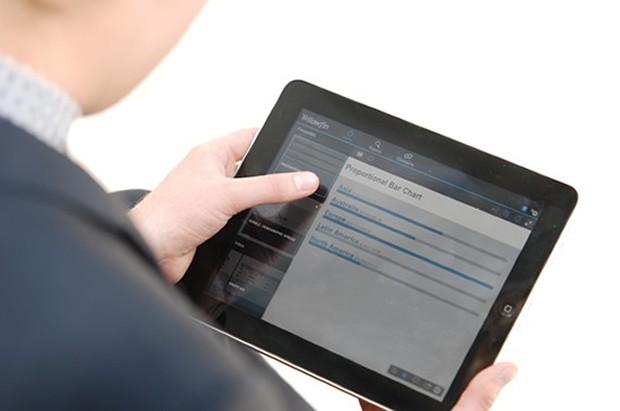
TechNavio’s 2012-2016: Global Mobile Business Intelligence Market report estimates that 2013 global tablet shipments will jump 81 percent from 2012, with a total of 109.5 million units shipped. Global tablet shipments are anticipated to hit 365 million units shipped by 2016. Analyst firm Ovum’s Solutions Guide: Mobile Business Intelligence report also expects the number of ‘big screen’ mobile devices to mushroom – although its estimates are a little more conservative. Ovum expects the number of tablet devices to rise from around five million in 2008 to 75 million in 2015 – a 682 percent absolute growth rate over the specified seven-year period.
Download the full report, Solutions Guide: Mobile Business Intelligence, HERE >
Android tablets to make ground on iPad
It appears likely that Google will quickly gain ground on business-oriented iPad implementations in 2013. Figures from IDG’s abovementioned survey add credence to the pro-Android stance, with 47 percent of business professionals predicting Google will lead the global tablet market by the end of 2013, and 48 percent listing Apple.
What underscores this trend, is the fact that whilst 51 percent of survey participants currently own an iPad (compared to 38 percent that own an Android tablet), 44 percent intend to purchase an Android tablet in the future, while just 27 percent say their next tablet purchase will be an iPad.
Mobile BI usage to be stimulated by increases in general mobile device usage
More generally, Mobile BI usage will be boosted throughout 2013 by the continuing growth of worldwide mobile device usage. A recent analysis of the global mobile market by Cisco found that the number of people adopting mobile devices was skyrocketing, with smartphone adoption rates increasing by 81 percent in 2012 from 2011. Unsurprisingly, mobile data traffic also rose by 70 percent over the same period. Cisco estimates that there will be more mobile devices than people by the end of 2013.
Mobile BI action; not just interest
It’s been well documented for several years now that organizations have strong ‘interest’ in Mobile BI and its potential benefits. The difference in 2013, according to research and advisory firm Ovum, is that a number of critical developments in the BI and analytics marketplace have now enabled that interest to transform into action.
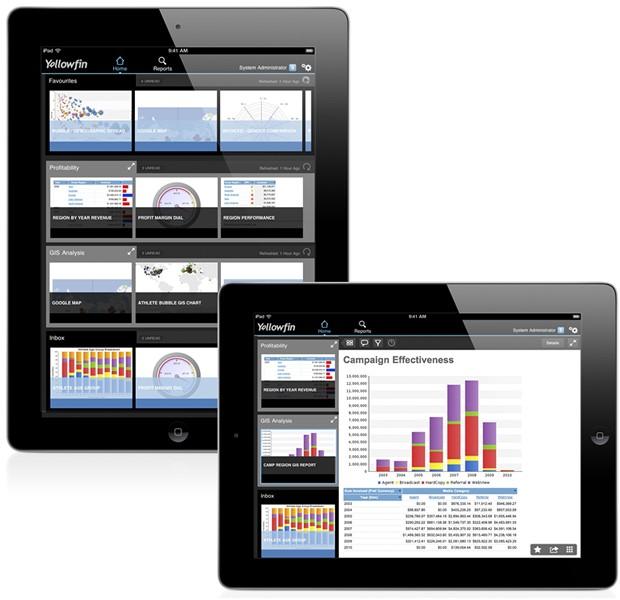
“Mobile BI now appears to be on an adoption wave, aided by the perfect confluence of three underlying factors: a readily available selection of high-performance mobile devices, network infrastructure that allows for rapid sending and receiving of data, and the increasing need for businesses to quickly respond to changes to stay competitive,” said senior Ovum analyst, Fredrik Tunvall, in a statement in relation to the release of Ovum’s latest research into Mobile BI marketplace technologies, trends and adoption – Solutions Guide: Mobile Business Intelligence.
Tunvall – the report’s author – stated that Mobile BI had the potential to significantly increase overall BI user adoption rates, and enable a considerably wider audience with the fact-based insights gleaned from reporting and analytics.
"Mobile BI is about getting more people involved in the process, be it an expert or a novice," said Tunvall. “This [Mobile BI] will also be where we will see some of the most interesting and innovative developments in BI and analytics over the next few years.”
Where to next?
Watch out, with heroic vigilance, for the next installment of our omnipotent take on 2013’s major BI developments and trends.

Our just-in-time predictions spawn from two overarching trends, which are set to encapsulate and define BI in 2013. This year, the major advancements of the BI industry will result from the maturation and convergence of the industry’s most prominent developments.
1. BI usage will explode
Over the past two years, BI has moved into the mainstream – people know what it is, they understand its potential benefits, and many have already acted. In 2013, ambition and investment will be realized via tangible BI deployments. A Computer Weekly poll on major enterprise IT investments for 2013 revealed that 78 percent of respondents had BI at the top of their priority list. And, once again, analytics and BI ranked as the number one tech priority in Gartner’s most recent annual CIO study.

Warning: Images may be prone to DRASTIC metaphorical exaggeration…
A joint TechRepublic – ZDNet analytics and Big Data study, conducted in November 2012 and comprising survey results from 1,300 of their worldwide readership, provided strong evidence of ballooning usage. A majority (51.7%) of respondents said they used data analytics to make business decision on a daily basis. A further 18.1 percent plan to deploy some form of business analytics implementation over the next 12 months meaning that, if these plans come to fruition, almost 70 percent of global businesses will have an analytics project in place by the conclusion of 2013.
Research from independent technology and market research firm, Pringle & Company, suggests a complimentary trend, estimating that the global market for BI software and associated services will roughly double over the next four years. The firm approximates that the global BI software and services market will rapidly expand from $79 billion in 2012, to $143 billion in 2016.
Pringle & Company’s Principal Analyst, Tom Pringle, said that the findings – based on The Business Intelligence Software & Services Market, 2011-2016 market study – were being driven by the proliferation of data, data types and the broad potential uses of BI.

“As data volume and variety grows ever bigger, the necessary investment in technology and services to understand and successfully exploit its value will have to rise. Such high levels reflect not only growing understanding of the real-world business value of data-driven insights, but also demonstrate the substantial range and depth of skills required to adopt the necessary systems to successfully discover and act on them.”
Forrester Research predicts that global enterprise IT spending will increase by 5.4 percent during 2013, with BI and analytics as a major stimulant. The firm estimates global BI investments to rise by 11 percent in 2013, and a further 16 percent from 2013 levels in 2014.
“CIOs can expect to see their competitors doing a lot more on mobility, collaboration and business intelligence,” said Forrester analyst Andrew Bartels, in an interview with CIO Journal. “If you’re not doing these three things, there is a severe risk you’re going to fall behind.”
2. BI adoption to (finally) surge in 2013
Low, and long vaunted, BI user adoption rates will also improve in 2013 – for two reasons. As continued investments in 2013 boost the prevalence of BI throughout organizations and most major industries, sustained user adoption will follow as many nah-sayers witness the benefits of day-to-day fact-based decision-making first hand. Secondly, contemporary BI vendors are harnessing, developing and delivering modern functionalities – capable of bridging the historical complexity of traditional BI tools – which truly cater for the demands of an increasingly non-technical audience. Just think intuitive drag-and-drag interfaces, ‘self-service’ data exploration, instinctive visualization, mobile delivery that supports device independence, and collaborative features that enable both accurate dissection of information, as well as faster, smarter action by supporting natural organizational decision-making processes.

Nucleus Research predicts that infamously low BI user adoption rates will double during 2013, with Nucleus Research Principal Analyst, Hyoun Park, stating that the firm estimates regular analytics use to rise to around 30 percent within most enterprises inside the next 12 months. Park stated that this rise would be driven by the realization that “nearly all business decisions can be data-based.”
“Nucleus expects BI adoption will double worldwide in 2013 as greater usability for non-expert analytics users, lower-cost options including cloud and SaaS, and further efforts by vendors to make BI accessible to every user, will drive broader adoption of BI,” said Park.
3. 2013 will NOT be the year Excel ‘kills’ BI
When will BI be killed by Excel? This – one would have to assume deliberatively inflammatory question – was posted about this time last year on the Business Intelligence Group LinkedIn group. Almost 1000 comments later, this frequently fiery thread reached its apparent conclusion just last week after a string of narcissistic, antagonist and straight-out insulting exchanges. So why was this conversation so hotly contested? Well, many contributors probably felt the need to justify the legitimacy of their career, organization and industry. Evidently others were provoked by the irrationality of the question. There are many good arguments that expound BI’s worth. Aside from the breadth, depth and fluidity of modern BI functionality far outstripping Excel in many ways, Aditya Satyadev – a self-described entrepreneur from India – probably summed the debate up best: “the basic constraint with excel is that it’s a desktop application. You can load as much data as you want, and conduct your analysis, but when it comes to sharing the analysis / information across the enterprise, it becomes a bottleneck. Also, with everyone trying to do their own analysis on Excel, consistency of view is compromised – multiple versions will inevitably float across the enterprise.”
Ultimately, if Excel adequately addressed present-day reporting requirements, the modern BI industry wouldn’t be flourishing.

Ventana Research’s benchmark report – Decision-Making and Performance: Improving Essential Business Analytics and Technologies – highlights both the reliance on, and trepidation associated with, Excel for reporting. The report, based on a survey of business analysts, found that 78 percent of respondents regarded spreadsheets as an “important” or “very important” component of enterprise reporting. Simultaneously however, a mere 29 percent said they would trust the information within a spreadsheet.
Another Ventana report – Requirements for 21st Century Spreadsheets: Uses and misuses of a critical business technology – exposed the roots of this common mistrust, with 50 percent of survey participants admitting to “frequently” finding “major errors” in spreadsheets used for reporting. Further, 42 percent said that they discovered out-of-date information “frequently” or “all the time”.
So perhaps the more appropriate question would be to ask ‘when will Excel be killed by BI?’ But, with an estimated 500 million active Excel users worldwide, the premise of that question won’t eventuate either – at least not this year, or anytime in the foreseeable future.
If anything, it’s more likely that Excel will succumb to internal forces – Microsoft deciding to update and repackage the value that Excel offers into a new product – than external.
4. Mobile BI is now a ‘must have’
Forget it. 2013 isn’t the year of the snake. It’s the year of Mobile BI. Or, more particularly, it’s the year Mobile BI will transition from a point of differentiation – embraced by leading BI deployments – to a ‘must have’ checklist item for organizations serious about their BI implementations.
Must have Mobile BI mentality
Independent analyst and advisory firm, BI Scorecard, surveyed 634 BI practitioners in its 2012 Successful BI Survey, its sixth and most recent version of its report into BI adoption and trends.
As reported by Information Management, when asked what BI functionality and improvements they would be looking to adopt and embrace for 2013, 47 percent of respondents listed Mobile BI, only narrowly behind BI mainstay the dashboard (52%).
Results from BI Scorecard’s investigation were substantiated by findings from Forrester Research. Forrester’s most recent survey-based research indicates that around 25 percent of enterprises are already using Mobile BI applications, with a further 37 percent planning Mobile BI implementations in the short-term.
Principal analyst at Forrester Research, Boris Evelson, recently commented that: "Mobility is no longer a ‘nice to have’ – it will become the new BI mantra. Currently, Mobile BI adoption is behind the curve compared with other enterprise mobile applications. This is mainly due to the perceived lack of specific business use cases and tangible ROI. But Mobile BI caught up in 2012, will continue to progress in 2013, and will eventually become the norm. Why? Information workers can no longer wait to make decisions until they get back to the office – that may be too late."

As participants could select multiple 'drivers'; the total percentage will not equal 100
Results from a recent study by market intelligence firm, TechNavio, back Boris’ viewpoint, forecasting the worldwide Mobile BI market to increase at a compound annual growth rate of 27.47 percent over the period 2012 – 2016. The report, entitled 2012-2016: Global Mobile Business Intelligence Market, put total spend on Mobile BI devices and software at $702 million in 2012, predicting that figure to rise by another 25 percent to $878.1 million in 2013, reaching a staggering $1.8 billion by 2016.
The report identified marked increase in Mobile BI usage for sales-related activities as a major catalyst driving general Mobile BI usage throughout 2013.
Mobile BI to boost lackluster BI adoption rates in 2013
Rates of BI adoption have been a consistent talking point within the BI industry. Numerous research firms estimate adoption rates to languish anywhere between eight and 24 percent of potential users.
However, it’s likely that increased Mobile BI adoption in 2013 will help address this persistent problem – according to BI Scorecard founder, and author of the 2012 Successful BI Survey, Cindi Howson.

“Only a minority of companies have deployed Mobile BI, but for the ones who are successful, the adoption rate is at 39 percent,” commented Howson in relation to her 2012 Successful BI Survey. “That’s at least 15 percent higher than the industry average. I think it will be the technology that helps BI become more mainstream and impactful.”
Fellow research and advisory firm, Nucleus Research, came to a similar conclusion in its eleventh annual Top 10 Technology Predictions for 2013. Nucleus Research forecast that BI adoption would double worldwide in 2013, citing “further efforts from vendors to make analytics accessible to every user”.
Specialist Mobile BI analyst, Gartner’s Joao Tapadinhas, recently echoed that sentiment, predicating that Mobile BI users would constitute over 30 percent of the number of overall BI users, worldwide, by 2016.
Mobile BI usage spurred by proliferation of work-oriented tablets
The continued penetration of new mobile devices into the workplace will also assist the uptake of Mobile BI in 2013.
IDG Connect’s Global tablet ownership report suggests, based on a sample of 3124 respondents, that 71 percent of business and IT professionals own a tablet, with 61 percent of those tablet-owning-executives using this mobile device on a daily basis at work. Notably, of those executives who don’t currently own a tablet, 80 percent plan on purchasing one within the next 12 months. Consequently, IDG Connect predicts that by the end of 2013, over 94 percent of professionals will own a tablet.

TechNavio’s 2012-2016: Global Mobile Business Intelligence Market report estimates that 2013 global tablet shipments will jump 81 percent from 2012, with a total of 109.5 million units shipped. Global tablet shipments are anticipated to hit 365 million units shipped by 2016. Analyst firm Ovum’s Solutions Guide: Mobile Business Intelligence report also expects the number of ‘big screen’ mobile devices to mushroom – although its estimates are a little more conservative. Ovum expects the number of tablet devices to rise from around five million in 2008 to 75 million in 2015 – a 682 percent absolute growth rate over the specified seven-year period.
Download the full report, Solutions Guide: Mobile Business Intelligence, HERE >
Android tablets to make ground on iPad
It appears likely that Google will quickly gain ground on business-oriented iPad implementations in 2013. Figures from IDG’s abovementioned survey add credence to the pro-Android stance, with 47 percent of business professionals predicting Google will lead the global tablet market by the end of 2013, and 48 percent listing Apple.
What underscores this trend, is the fact that whilst 51 percent of survey participants currently own an iPad (compared to 38 percent that own an Android tablet), 44 percent intend to purchase an Android tablet in the future, while just 27 percent say their next tablet purchase will be an iPad.
Mobile BI usage to be stimulated by increases in general mobile device usage
More generally, Mobile BI usage will be boosted throughout 2013 by the continuing growth of worldwide mobile device usage. A recent analysis of the global mobile market by Cisco found that the number of people adopting mobile devices was skyrocketing, with smartphone adoption rates increasing by 81 percent in 2012 from 2011. Unsurprisingly, mobile data traffic also rose by 70 percent over the same period. Cisco estimates that there will be more mobile devices than people by the end of 2013.
Mobile BI action; not just interest
It’s been well documented for several years now that organizations have strong ‘interest’ in Mobile BI and its potential benefits. The difference in 2013, according to research and advisory firm Ovum, is that a number of critical developments in the BI and analytics marketplace have now enabled that interest to transform into action.

“Mobile BI now appears to be on an adoption wave, aided by the perfect confluence of three underlying factors: a readily available selection of high-performance mobile devices, network infrastructure that allows for rapid sending and receiving of data, and the increasing need for businesses to quickly respond to changes to stay competitive,” said senior Ovum analyst, Fredrik Tunvall, in a statement in relation to the release of Ovum’s latest research into Mobile BI marketplace technologies, trends and adoption – Solutions Guide: Mobile Business Intelligence.
Tunvall – the report’s author – stated that Mobile BI had the potential to significantly increase overall BI user adoption rates, and enable a considerably wider audience with the fact-based insights gleaned from reporting and analytics.
"Mobile BI is about getting more people involved in the process, be it an expert or a novice," said Tunvall. “This [Mobile BI] will also be where we will see some of the most interesting and innovative developments in BI and analytics over the next few years.”
Where to next?
Watch out, with heroic vigilance, for the next installment of our omnipotent take on 2013’s major BI developments and trends.